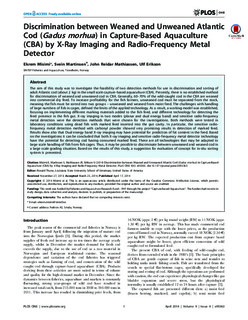| dc.contributor.author | Misimi, Ekrem | |
| dc.contributor.author | Martinsen, Svein | |
| dc.contributor.author | Mathiassen, John Reidar Bartle | |
| dc.contributor.author | Erikson, Ulf Gøran | |
| dc.date.accessioned | 2019-02-15T17:45:22Z | |
| dc.date.available | 2019-02-15T17:45:22Z | |
| dc.date.created | 2014-09-03T10:45:05Z | |
| dc.date.issued | 2014-04-17 | |
| dc.identifier.citation | PLoS ONE. 2014, 9 (4), . | nb_NO |
| dc.identifier.issn | 1932-6203 | |
| dc.identifier.uri | http://hdl.handle.net/11250/2585775 | |
| dc.description.abstract | The aim of this study was to investigate the feasibility of two detection methods for use in discrimination and sorting of adult Atlantic cod (about 2 kg) in the small scale capture-based aquaculture (CBA). Presently, there is no established method for discrimination of weaned and unweaned cod in CBA. Generally, 60–70% of the wild-caught cod in the CBA are weaned into commercial dry feed. To increase profitability for the fish farmers, unweaned cod must be separated from the stock, meaning the fish must be sorted into two groups – unweaned and weaned from moist feed. The challenges with handling of large numbers of fish in cages, defined the limits of the applied technology. As a result, a working model was established, focusing on implementing different marking materials added to the fish feed, and different technology for detecting the feed presence in the fish gut. X-ray imaging in two modes (planar and dual energy band) and sensitive radio-frequency metal detection were the detection methods that were chosen for the investigations. Both methods were tested in laboratory conditions using dead fish with marked feed inserted into the gut cavity. In particular, the sensitive radio-frequency metal detection method with carbonyl powder showed very promising results in detection of marked feed. Results show also that Dual energy band X-ray imaging may have potential for prediction of fat content in the feed. Based on the investigations it can be concluded that both X-ray imaging and sensitive radio-frequency metal detector technology have the potential for detecting cod having consumed marked feed. These are all technologies that may be adapted to large scale handling of fish from fish cages. Thus, it may be possible to discriminate between unweaned and weaned cod in a large scale grading situation. Based on the results of this study, a suggestion for evaluation of concept for in-situ sorting system is presented. | nb_NO |
| dc.description.sponsorship | This work was funded by Fisheries and Aquaculture Research Fund – FHF through the project “Capture-based Aquaculture”. The funders had no role in study design, data collection and analysis, decision to publish, or preparation of the manuscript. | nb_NO |
| dc.language.iso | eng | nb_NO |
| dc.rights | Navngivelse 4.0 Internasjonal | * |
| dc.rights.uri | http://creativecommons.org/licenses/by/4.0/deed.no | * |
| dc.title | Discrimination between weaned and unweaned atlantic cod (Gadus morhua) in capture-based aquaculture (CBA) by X-ray imaging and radio-frequency metal detector | nb_NO |
| dc.type | Journal article | nb_NO |
| dc.type | Peer reviewed | nb_NO |
| dc.description.version | publishedVersion | nb_NO |
| dc.rights.holder | Copyright: © 2014 Misimi et al. This is an open-access article distributed under the terms of the Creative Commons Attribution License, which permits unrestricted use, distribution, and reproduction in any medium, provided the original author and source are credited. | nb_NO |
| dc.source.pagenumber | 9 | nb_NO |
| dc.source.volume | 9 | nb_NO |
| dc.source.journal | PLoS ONE | nb_NO |
| dc.source.issue | 4 | nb_NO |
| dc.identifier.doi | 10.1371/journal.pone.0095363 | |
| dc.identifier.cristin | 1151409 | |
| cristin.unitcode | 7566,2,0,0 | |
| cristin.unitname | Sjømatteknologi | |
| cristin.ispublished | true | |
| cristin.fulltext | original | |
| cristin.qualitycode | 1 | |

